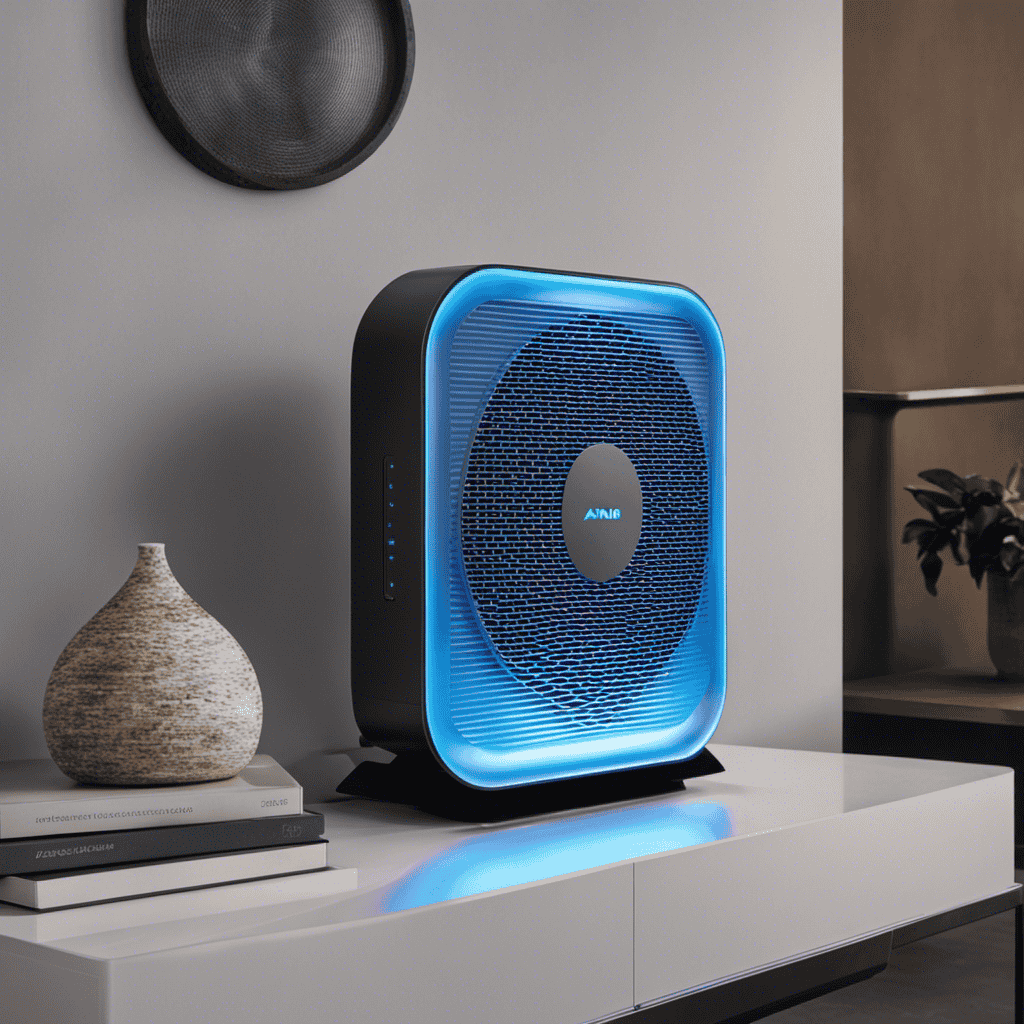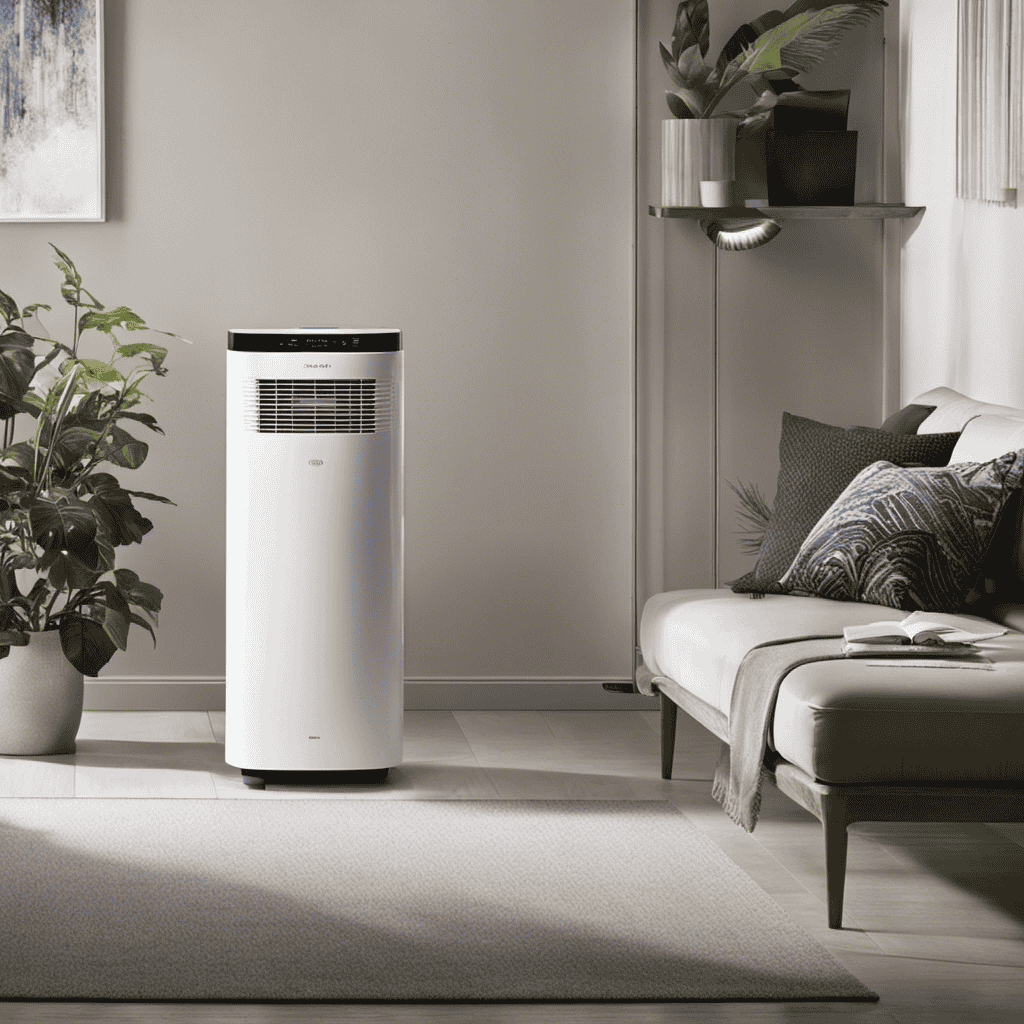I’ve been in that situation before – staring at my air purifier’s display, puzzled by the meaning of those two letters, ‘PM.’ But fret not, I’m here to clarify things for you.
PM stands for ‘Particulate Matter,’ and it’s a crucial measurement of air quality. Understanding PM levels is essential for our health and well-being.
In this article, we’ll explore the significance of PM on air quality, how it’s measured in air purifiers, and offer tips for improving indoor air quality.
So, let’s dive into the world of PM and demystify your air purifier readings.
Key Takeaways
- PM stands for Particulate Matter and refers to tiny particles suspended in the air.
- PM pollution can lead to respiratory problems, cardiovascular issues, and premature death.
- Measuring PM in air purifiers helps determine their effectiveness in improving indoor air quality.
- Choosing the right air purifier with proper maintenance can effectively remove PM particles and improve air quality.
Understanding PM Levels
To understand PM levels, you’ll need to know that PM stands for particulate matter. PM refers to tiny particles suspended in the air that can be harmful to our health. These particles can come from various sources such as dust, pollen, smoke, and vehicle emissions.
PM pollution is a major concern worldwide, as it can lead to respiratory problems, cardiovascular issues, and even premature death. Monitoring PM levels is crucial to assess air quality and take necessary actions to minimize exposure.
PM levels are typically measured using specialized instruments that can detect and quantify the concentration of these particles in the air. By understanding PM levels, we can make informed decisions to protect our health and reduce the impact of PM pollution on our environment.
The Significance of PM on Air Quality
The significance of PM on air quality can be understood by considering its impact on health. PM, or particulate matter, refers to tiny particles suspended in the air that can be inhaled into our lungs. These particles come from various sources, including vehicle emissions, industrial processes, and natural sources like dust and pollen. The presence of high PM levels in the air can lead to serious health problems, particularly for vulnerable populations such as children, the elderly, and those with respiratory conditions.
Here are some key points to consider about PM and air pollution:
- PM levels are measured based on the size of the particles, with smaller particles being more harmful.
- Exposure to high levels of PM can cause respiratory issues, cardiovascular problems, and even premature death.
- PM can also contribute to the formation of smog and haze, reducing visibility and impacting overall air quality.
- Certain locations, such as urban areas and industrial zones, tend to have higher PM levels due to increased human activity.
- Efforts to reduce PM levels include implementing stricter emissions standards, promoting cleaner technologies, and improving air quality monitoring systems.
Understanding the significance of PM on air quality is crucial for implementing effective measures to mitigate air pollution and protect public health.
How PM Is Measured in Air Purifiers
Measuring PM in air purifiers helps determine the effectiveness of these devices in improving indoor air quality.
PM, or particulate matter, refers to tiny particles suspended in the air that can be harmful to our health. Air purifiers are designed to filter out these particles, but it is essential to measure the levels of PM in both the outdoor environment and indoor spaces to ensure their efficiency.
In the outdoor environment, PM is measured using sophisticated instruments that can detect and quantify the concentration of particles of different sizes. These measurements are crucial in establishing PM standards and regulations to protect public health.
The Health Effects of PM Pollution
Understanding the health effects of PM pollution is crucial for protecting yourself and your loved ones from potential harm. PM, or particulate matter, refers to tiny particles in the air that can be inhaled into our lungs. These particles can come from various sources, such as vehicle emissions, industrial processes, and natural sources like dust and pollen.
Here are some key points to consider about the link between PM pollution and respiratory diseases, as well as the role of PM in outdoor air pollution:
- PM pollution has been linked to respiratory diseases such as asthma, bronchitis, and even lung cancer.
- The smaller the particle size, the deeper it can penetrate into our lungs, increasing the risk of health problems.
- PM pollution can worsen existing respiratory conditions and trigger symptoms like coughing, wheezing, and shortness of breath.
- Outdoor air pollution, including PM pollution, is a significant environmental risk factor for global health.
- Reducing PM pollution is essential for protecting public health and improving air quality.
Considering the health risks associated with PM pollution, it becomes crucial to choose the right air purifier for PM removal.
Choosing the Right Air Purifier for PM Removal
To effectively choose the right air purifier for removing PM, you should consider the size of your room and the Clean Air Delivery Rate (CADR) that meets your needs.
When it comes to air purifier maintenance, it’s essential to understand the benefits of using an air purifier in the first place. Air purifiers not only remove PM particles from the air, but they also help eliminate other pollutants like dust, pet dander, and pollen.
Regularly maintaining your air purifier ensures optimal performance and extends its lifespan. This includes cleaning or replacing filters as recommended by the manufacturer and keeping the unit free from dust and debris.
Tips for Improving Indoor Air Quality and Reducing PM
Maintaining a clean and dust-free environment is crucial for improving indoor air quality and reducing PM particles. Here are some tips to help you achieve this:
- Improve ventilation by opening windows and using exhaust fans to bring in fresh air and remove indoor pollutants.
- Use natural air purifiers like plants, which can help filter out toxins and improve air quality.
- Regularly clean and vacuum your home to remove dust, pet dander, and other particles that can contribute to PM pollution.
- Avoid smoking indoors, as cigarette smoke is a significant source of PM particles.
- Consider using air purifiers with HEPA filters, which are designed to capture even the smallest particles.
By implementing these practices, you can create a healthier indoor environment and reduce the presence of PM particles.
Now, let’s explore the common sources of PM in indoor environments.
Common Sources of PM in Indoor Environments
Identifying the common sources of PM in your indoor environment is essential for effectively reducing its presence. PM, or particulate matter, refers to tiny particles and droplets suspended in the air. These particles can come from various sources and can have detrimental effects on our health. Understanding where PM pollution originates from is crucial in taking appropriate measures to improve indoor air quality.
| Sources of PM Pollution | Health Effects of PM |
|---|---|
| Tobacco smoke | Respiratory issues |
| Cooking emissions | Asthma |
| Dust and dirt | Allergies |
| Mold and mildew | Lung infections |
| Pet dander | Cardiovascular issues |
Tobacco smoke is a significant contributor to indoor PM pollution and can lead to respiratory problems. Cooking emissions, such as from frying or burning food, can release PM particles that can trigger asthma attacks. Dust and dirt can accumulate in indoor spaces and contain PM particles that can cause allergies. Mold and mildew can release spores into the air, leading to lung infections. Lastly, pet dander, which consists of tiny particles shed from animals, can also contribute to PM pollution and can aggravate cardiovascular issues.
Troubleshooting PM Readings on Your Air Purifier
When it comes to troubleshooting PM readings on your air purifier, there are a few key points to consider.
Firstly, a common issue may be a PM sensor malfunction, which can result in inaccurate readings. To address this, it is important to clean your air purifier regularly, as dust and debris can accumulate on the sensor and affect its functionality.
Lastly, interpreting PM readings requires an understanding of the different levels and classifications of particulate matter, as well as the specific guidelines and thresholds set by regulatory agencies.
PM Sensor Malfunction
If your air purifier’s PM sensor is malfunctioning, you may notice inaccurate readings of the air quality. This can be frustrating, but there are solutions available. Here are some important things to know about PM sensor malfunctions:
-
PM sensor calibration: Regular calibration of the PM sensor is crucial to ensure accurate readings. Check your air purifier’s user manual for instructions on how to calibrate the sensor properly.
-
Replacing the PM sensor: If calibration doesn’t solve the issue, it might be necessary to replace the PM sensor. Contact the manufacturer or refer to the user manual for guidance on how to replace the sensor.
-
Troubleshooting guide: Look for a troubleshooting guide specifically for PM sensor issues. This guide can provide step-by-step instructions on how to diagnose and fix the problem.
-
Professional assistance: If all else fails, consider seeking professional assistance from an air purifier technician who can diagnose and repair the malfunctioning PM sensor.
-
Regular maintenance: To prevent future malfunctions, it’s important to perform regular maintenance on your air purifier, including cleaning the filters, checking for any loose connections, and ensuring proper ventilation.
Once you have addressed the PM sensor malfunction, it’s time to move on to the next step: cleaning your air purifier.
Cleaning Air Purifier
To ensure optimal performance, it’s important to regularly clean the filters and maintain proper ventilation in your air purifier. Cleaning techniques will vary depending on the type of air purifier you have. For most models, it’s recommended to clean the filters every three to six months. This can be done by gently vacuuming or washing them with mild soap and water.
Additionally, it’s crucial to check the manufacturer’s guidelines for specific maintenance instructions. Regularly inspecting the exterior of the purifier for dust and debris buildup is also essential. Keeping a maintenance schedule will help ensure that your air purifier operates efficiently and effectively.
Now that we’ve covered the importance of cleaning and maintenance, let’s move on to interpreting PM readings.
Interpreting PM Readings
Understanding what the PM readings indicate can help you assess the air quality in your home. PM stands for particulate matter, which refers to tiny particles suspended in the air. These particles can come from various sources, such as dust, smoke, pollen, and pollutants from vehicles and industrial activities. Interpreting PM data requires knowledge of the different sizes of particles and their potential health effects.
Here are five key points to consider when interpreting PM readings:
- PM2.5 refers to particles with a diameter of 2.5 micrometers or smaller, which can penetrate deep into the lungs.
- PM10 includes larger particles up to 10 micrometers in diameter, which can irritate the respiratory system.
- High PM levels may indicate poor air quality and potential health risks.
- PM monitoring techniques involve using sensors to measure the concentration of particles in the air.
- Comparing PM readings to established air quality standards can help determine if the air is safe to breathe.
Frequently Asked Questions
Can PM Levels on Air Purifiers Be Adjusted According to Personal Preferences?
Yes, the effectiveness of adjustable PM levels on air purifiers depends on personal preferences. By customizing the PM levels, individuals can have a greater impact on the air quality in their homes.
Can Air Purifiers Completely Eliminate All PM Pollution From Indoor Environments?
Air purifiers can greatly reduce PM pollution indoors, but complete elimination depends on various factors. Different brands have varying effectiveness. Factors contributing to high PM levels include smoking, cooking, and outdoor pollution.
Is It Necessary to Regularly Clean or Replace the Filters in Air Purifiers to Maintain Their Effectiveness in Removing Pm?
Regularly cleaning or replacing air purifier filters is necessary to maintain their effectiveness in removing PM. This maintenance ensures that the filters continue to trap and remove particles, promoting cleaner indoor air and providing the benefits of improved respiratory health.
How Long Does It Take for an Air Purifier to Reduce PM Levels in a Room?
It typically takes an air purifier a few hours to reduce PM levels in a room, depending on its effectiveness and various factors like room size, air flow, and initial PM concentration.
Can Air Purifiers Remove PM Pollution From Outdoor Air That Enters Indoor Spaces?
Air purifiers can effectively reduce PM pollution indoors by filtering out particles from outdoor air. To compare models for PM removal efficiency, consider factors such as HEPA filters, CADR ratings, and ACH rates.
Conclusion
In conclusion, understanding the meaning of PM on your air purifier is crucial for maintaining a healthy indoor environment. By measuring and monitoring PM levels, you can effectively remove harmful pollutants and improve air quality.
Choosing the right air purifier that specifically targets PM removal is essential for optimal results. Additionally, implementing strategies to reduce PM sources and improve indoor air quality can further enhance the effectiveness of your air purifier.
By taking these steps, you can create a clean and fresh environment that promotes overall well-being. So, let your air purifier be the knight in shining armor, fighting off the invisible enemies that threaten your health and comfort.










